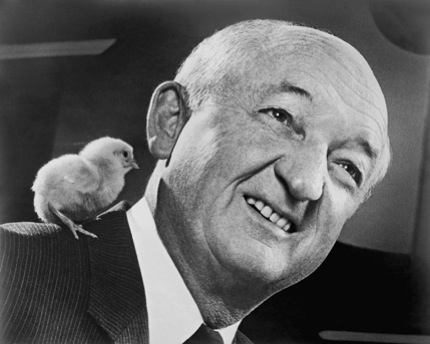Frank Perdue (1920-2005)

“Baldness. Handsome in a man, Beautiful in a Chicken.”
“It takes a tough man to make a tender chicken.
This is a story of a family of entrepreneurs – a dynasty today which started with Arthur Perdue’s involvement with chickens back in 1920. In order to have a little extra money, Arthur spent $5 and bought 50 layer hens and entered the egg business in Salisbury, Maryland. In a short time he was able to quit his job as a railroad express worker and devote all of his time to selling eggs to the New York City market. Arthur Perdue monitored his costs carefully, refused to borrow money, and took great pride in his eggs, proclaiming their superiority to everyone. He also passed his philosophy onto Frank Perdue, his young son, whose flock was soon out producing his father’s. Frank had learned early on that contented chickens laid more eggs and to make chickens happier all that was necessary was to provide larger pens.
In 1937 Frank gave up his dream of becoming a major-league baseball player and joined his father’s egg business. By 1940 their company switched from eggs to selling chickens. Frank experimented and came up with a feed that was superior to anything on the market. In 1953 the Perdues went into the feed business, selling their product to other farmers in the area. It was 1968 when Frank decided to start advertising on radio and television. His ad agency persuaded him to be the company’s leading spokesman and trademark, a daring concept in a period of faceless corporate executives. This strategy proved successful. Frank’s bald head and homely appeal caught the public imagination. Some noted that Perdue’s face resembled that of a chicken.
Herbert Hoover once spoke of “a chicken in every pot,” an indication that in the late 1920s chickens were a delicacy, more prized than beef or pork. In the 1940s chicken was deemed a proper Sunday dinner, but not for long. As the cost of raising chickens declined, so did their price in the market place. Where the Americans of the 1940s went for meat and potatoes, their counterparts of the 1950s and beyond called for chicken and fries. Colonel Harland Sanders with his recipe of 11 herbs and spices reaped a fortune franchising Kentucky Fried Chicken. President John F. Kennedy began the nation on a physical fitness program. By the 1970s joggers were searching for food low in calories, fat, and cholesterol and a diet of chicken fit the bill as it ranked better than beef or pork in all three areas. Then along came “Chicken McNuggets” and before long McDonald’s was the second largest chicken retailer. Perdue Farms responded by making a major push in the chicken parts market. Today Perdue’s operations includes breeding stock, hatcheries, feed mills soybean facilities and a hugh fleet of refrigerated trucks. Waste products are used for feed and it can be said that Perdue uses “everything but the cluck.”
In 1991 Frank retired and turned the family-owned business over to his son, Jim, who now carries on his grandfather’s tradition of furnishing chickens of the highest quality. It is said that annual sales equal $2.7 billion while Forbes Magazine ranks them 4th in the nation in the poultry business. This empire started with a simple commitment to quality and a continueing pride its product through clever advertising.
It is interesting to note that chicks are naturally yellow when hatched, but will lose their coloring if not fed a proper diet of corn, soybean meal, vitamins, minerals, and marigold petals. You can easily recognize a Perdue Brand chicken by its golden color.
